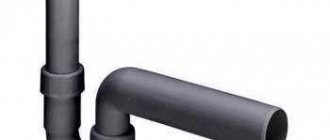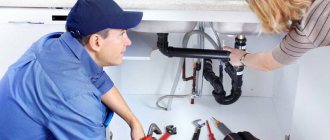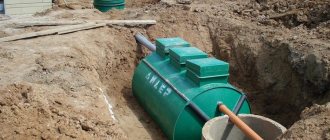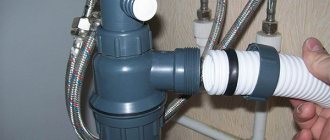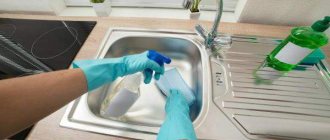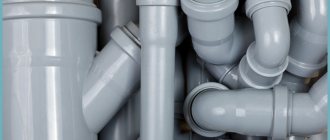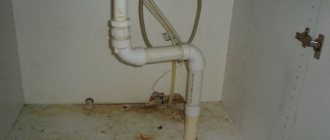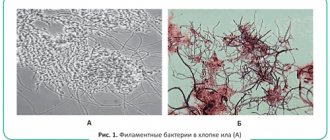A sewer smell appears in the bathroom from the drainage system due to breakdown, drying out, or lack of a water seal in the plumbing products. Less commonly, the cause is a leak at the joint of the internal sewer, the absence of a drain pipe, or an insufficient slope of horizontal lines.
You can eliminate the unpleasant smell in the bathroom with your own hands in a short time at minimal cost. To do this, you need to know the structure of the drainage system, water seal and sewer ventilation.
What are the dangers of sewer smell?
A spoiled mood, unpleasant-smelling towels or laundry drying in the bathroom are not the only unpleasant consequences of a “bad aroma.” The other side of the “tasteless coin” is much more dangerous: air, which contains ammonia, methane, hydrogen sulfide and other dangerous compounds. Inhaling such a flammable mixture provokes irritability, anxiety, insomnia, and an unreasonable feeling of complete weakness.
Prolonged contact with hydrogen sulfide can cause pathologies of the respiratory system, including rhinitis and bronchitis. Another potential danger is vapor poisoning. Its signs are dizziness, headache, nausea, decreased blood pressure. Ammonia can cause vision problems, methane can provoke oxygen starvation of cells, and problems with the autonomic nervous system.
For these reasons, when strange, unusual “odors on the contrary” appear, the owners should immediately “ring the alarm.” You need to find out in advance how to eliminate sewer smell in the bathroom. Awareness will give you a chance to deal with the problem as quickly as possible, otherwise the negative consequences due to the growing concentration of gases will definitely make themselves felt. Such fumes are especially dangerous for children and elderly people with high blood pressure; they are harmful to healthy people and pets.
Additional Tips
To protect yourself from the problem of unpleasant odor in the bathroom, you should listen to the following recommendations:
- Entrust the development of the project and installation of the home drainage system to experienced professionals.
- When choosing a sealant for sealing cracks, it is advisable to give preference to compounds that contain antibacterial and fungicidal additives.
- In summer, without use, the siphon quickly dries out; to restore the hygienic condition of the bathroom, just pour water into it.
All the most important and useful information about cleaning the bathroom is collected in this section of the site.
Sewerage and its weak points
Before looking for possible ways to eliminate sewer smell in the bathroom, you need to study the drainage system. It includes risers, interior pipes, drains and plumbing siphons. The last element, equipped with a water seal, is responsible for protection against foreign odors. This is a “plug” of water located in the bend of the siphon. It prevents odor from penetrating into apartments. If for some reason this water lock is deprived of liquid, then the “aromas” of the sewer drain begin to flow freely into the bathroom.
Another possible reason lies in the disturbances that appear in the operation of the common riser. For its normal functioning, a constant flow of air is required through the fan (exhaust) pipe, which is installed at the top of the riser. Its blockage or violation of its position leads to the fact that odors are able to penetrate into apartments through siphons. Their water seal disappears because it is sucked into the sewer system. Most often, trouble happens with bathtub siphons, since they are located as low as possible.
No siphons
First of all, the plumbing user needs to understand the following points of the technological process of the drainage system:
- gray wastewater is removed by gravity into the sewer riser, black wastewater is discharged there in one gulp when flushed from the tank;
- in the riser, gray wastewater is mixed with black wastewater and enters the collector of the city sewerage system near each multi-story building;
- it is in the collector that the organic matter contained in the wastewater begins to decompose by bacteria;
Sewage diagram of an apartment building. - in this case, biogas is released, consisting of water vapor, ammonia NH3, methane CH4, carbon dioxide CO2, hydrogen sulfide H2S, nitrogen N2;
- at low concentrations, hydrogen sulfide is easily recognized by the stench of rotten eggs;
- dangerous toxic high concentrations of hydrogen sulfide are not perceived by the human olfactory organs;
- a helpless state occurs after 10–20 breaths, and air saturated with H2S becomes explosive;
- therefore, the sewer system is equipped with its own ventilation system, through which the listed gases are removed;
Sewer ventilation. - the intra-house drainage system of a high-rise building is connected to the atmosphere by a drain pipe, which is a continuation of the riser above the top floor;
- in apartments, the internal sewage system, on the contrary, must be absolutely sealed;
- To ensure tightness, a siphon with a water seal is installed at the drain of each plumbing fixture, which does not allow gases from the drainage system manifold with harmful, unpleasant odors to enter the room.
Water seal inside siphon
The most common mistake is installing sinks in the bathroom without siphons. This unit is built into the toilet; connecting a bathtub without a siphon will not work, since it is included in the package. But for a sink, sink, washbasin, a corrugation is often purchased that directly connects the drain to the sewer tee. Biogas from the collector does not encounter obstacles in the form of a water plug and freely exits into the bathroom of the unsuspecting apartment owner.
Types of sewer siphons.
In this case, getting rid of the smell of spoiled eggs using your own resources is quite simple. You need to increase the length of the corrugated pipe, make a U-shaped or Z-shaped loop on it, or buy a bottle-type siphon.
If the room has an emergency drain for draining leaks, several liters of water must be poured into it periodically to prevent the water seal from drying out.
Potential Causes
This “fragrant” nuisance can be caused by several factors.
- Incorrect design or errors made during sewer installation. In this case, neither household chemicals nor air fresheners will be able to cope with the problem. The only correct solution would be to remake the system, but the work requires qualified craftsmen.
- Incorrect slope of sewer pipes. It must be sufficient so that wastewater does not have the opportunity to stagnate. If such conditions are created for her, then an unpleasant smell in the bathroom is guaranteed. The solution is to rebuild the pipeline.
- High pressure in the sewer system. This causes air bubbles to escape through the siphon. The pipes that are completely clogged with drains are to blame for this. Trouble is caused by blockages, icing, and insufficient diameter of the channels.
- Clogged pipe. Since hair, fur, and dirt particles regularly get into them, voluminous lumps form there. They become an obstacle-magnet for further portions of dirt, gradually turning into unpleasant-smelling traffic jams.
- Minor leaks. A large “ocean” in the bathroom is easy to spot, but a small puddle is quite easy to miss. Dirty water, regularly accumulating and evaporating, will constantly provoke the appearance of suspicious odors.
- Incorrectly functioning ventilation. If it is clogged, the result will be similar. The room will have musty air, constant dampness, and soon an unexpected guest will inevitably appear - mold.
- Rare use of the sink. In this case, the reason is simple: the water seal has dried out. The “treatment” is also simple: filling it with water. It is better to make a solution with a disinfectant.
Incorrect installation of the system cannot be corrected on your own. This work should be done by professionals. The remaining problems - blockages, problems with siphons and leaks - are quite easy to fix on your own.
In this case, it is important to find the reason in time, the source of the “unforgettable amber.” If the bathroom is shared, then the circle of “suspects” expands. You will have to check the common riser, as well as the toilet and communications leading to it.
Causes
Before taking serious measures to eliminate odors in the bathroom, it is recommended to understand the reasons for their occurrence. Some residents can handle on their own, but in other situations they will have to resort to the help of specialist plumbers.
So, the most common sources:
- The sewer plug is installed by housing and communal services, especially for persistent defaulters of utility services as a punishment. It blocks the outflow of wastewater, which quickly collects, accumulates and its level rises higher and higher, eventually exiting through the toilet. The waste in this water begins to decompose and clog the pipes. As a result, the stench spreads throughout the apartment, and over time it becomes almost impossible to drain the water. It is not possible to remove the plug legally, and modern technologies offer plugs of this type that cannot be manipulated from the outside, and unauthorized actions by household members can provoke a serious flood.
- If the “smell” appeared immediately after moving to a new home, with a high degree of probability the cause lies in an incorrectly installed watercourse system. In this case, you will have to involve specialists in solving a complex problem and change absolutely all the pipes, which entails considerable costs. The root of the problem is the angle of inclination of the pipes, at which waste flows out unevenly, lingering in certain areas and creating serious blockages.
- Siphon can also cause this phenomenon. The water seal itself is a curved tube in which water collects, which prevents the spread of unpleasant odors. Various types of disruptions often occur in the operation of this barrier, which leads to the filling of the room with a nauseating “smell.” This is due to:
- When the water seal cavity is completely filled with waste, the water is removed and the mechanism becomes empty.
- High pressure (above atmospheric) when air bubbles rise upward.
- Hidden and obvious leaks. In this case, puddles of liquid form, but due to the presence of immovable furniture and plumbing equipment in the bathroom, they may remain invisible. Detection therefore requires a thorough examination of the entire outdoor system for leaks.
- Poor ventilation is one of the most obvious reasons for the appearance. You can check its serviceability in a simple “old-fashioned way”. To do this, take a napkin or sheet of paper and attach it to the grill. If the paper does not hold up due to air draft and does not fall, then the air circulation is normal, and the source of the stench should be looked for elsewhere.
- One of the most obvious factors is clog. This happens due to the accumulation of various debris: hair, food debris, dirt and much more. There are many devices that can help unclog drains, from the traditional steel cable to modern special gadgets.
How to eliminate sewer smell in the bathroom?
Sometimes, to prevent an unpleasant situation, it is enough to regularly deal with blockages. Often, owners need to take preventive measures in time - install simple mesh filters in drains that trap any dirt, hair, or animal fur. If the problem was caused by improper installation of the bathtub siphon, then you can deal with this problem yourself.
The first thing to do is check the ventilation - with a lighter, a napkin or a sheet of paper. A vertical flame or a falling leaf are facts indicating that the ventilation is not working well enough. Then they move on to examining the sink and bathtub. To do this, check the plumbing fixtures one by one with a powerful stream of water. When it is discovered that the water is reluctant to drain, then we can say with confidence that the culprit has been found; it is a blockage.
If the drain works flawlessly, but you cannot cope with the smell, then you can try using very hot water. If there is no result, the test continues: using a flashlight, inspect and feel all the joints of the elements for leaks. To find the area, use napkins or toilet paper, which will instantly get wet and show the presence of a leak. After finding problem areas, they are sealed.
If the cause has been discovered, then you can begin to eliminate it. There are several ways to fight. These include:
- cleaning of sewer pipes - mechanical, chemical, or using improvised means;
- cleaning the ventilation duct to normalize air exchange;
- repair, cleaning or filling the siphon.
The first operations can be easily done with your own hands. Many people can “figure it out” with a siphon, but sometimes owners prefer to rely on the help of competent specialists.
Folk remedies
In some cases, the help of strong drugs is not needed, since it is relatively easy to eliminate the smell of sewerage in the bathroom using ordinary products that can be found in every home. These are soda, vinegar and citric acid. Such products allow you to destroy deposits and at the same time disinfect pipes. They can be used either separately or together.
- Soda or salt. Half a standard pack of soda, or the same volume of salt, is poured into the sink or bathtub drain. After 20-30 minutes it is washed with hot water.
- Soda and vinegar. First, pour soda (1/2 cup) into the drain, then pour a glass of vinegar. The drain must be closed with a stopper (or cloth). After half an hour, the pipe is also washed with plenty of hot water. It is better to use boiling water.
- Soda with citric acid. This “duet” is often used to remove scale from dishes. It is also effective against sewer “constipation”. They begin to wash the soda and acid when the formation of foam stops and the hissing ceases to be heard.
Another simple remedy is Whiteness, almost everyone has it. This chlorine-containing liquid can also help break up blockages that have formed in the sewer. The undiluted product is poured into the drain, and after 20 minutes it is washed with hot water. The smell will disappear and the drain will start working faster.
If the means at hand do not help, you will have to turn to “professional” plumbing products for help.
Help chemicals
This is the second simple, but effective, and therefore popular method. But caution is important when working with chemicals. Gloves are required, it is recommended to wear a respirator, contact of strong drugs on the skin and mucous membranes is unacceptable.
In stores you can find a wide range of various household chemicals: both imported and domestic. However, even plumbers answer the question about the best product in the same way: they say that Mole powder copes quite effectively with any blockages. It is poured into the drain and left for at least 4-5 hours, but it is better to let it “work” longer. It is recommended to send the mole down the drain in the evening, and clean it with a stream of water only in the morning.
Other popular products: Domestos, Mister Muscle, Pothan, Sanox, Steril-S, Tiret, Floop. Preparations can be liquid or granular. The latter, more concentrated, are considered the most effective. Their peculiarity is the need to strictly adhere to doses and control the duration of action, since chemicals can damage pipes made of plastic.
Mechanical cleaning: plunger or cable
Often a simple solution cannot help. In this case, the owners have to perform physical exercises. The plunger becomes a traditional lifesaver. In case of slight stagnation of water, it helps to cope with the problem, but in difficult cases it is not enough.
If the plug is large, and it is located far from the drain, then “heavy artillery” is needed - a plumbing cable. It is pushed into the drain hole with rotational movements. Once the tip reaches the accumulation of debris, it is removed. Cleaned pipes are thoroughly washed with hot water. Sometimes pipe bends do not allow you to achieve the goal, so there is only one option left - the help of a plumber.
Repairing leaks
If gaps are found at the joints through which water flows, they can be sealed with FUM tape. There is a more reliable way - using sealants. Among the most popular materials are Moment, Ceresit, Ciki Fix, Tytan. The list of sealants suitable for plumbing work is quite wide:
- Acrylic. Among their positive qualities are good water-repellent characteristics, resistance to temperature changes, and reliability, guaranteeing an impressive service life. The downside is lack of elasticity.
- Silicone. Their difference is their high price, which makes the materials not very attractive to buyers. However, these sealants are characterized by elasticity, good adhesion, lack of shrinkage, and fear of temperature changes.
- Silicone-acrylic. They are characterized by the best qualities of individual component materials, so this is one of the best options for repairing sewer pipes.
- Polyurethane. They can be painted, so they can be used to mask sealed areas. The downside is the smell, but it disappears immediately after it hardens.
How to eliminate sewer smell in the bathroom using sealants? Before the main work, the surfaces are prepared: first they are cleaned of dirt and dust, dried, then degreased. The sealant is applied in a circle, in a continuous line. For leveling or application, use a soft spatula. The sewer is not touched (the water is not opened) until the seam is completely set.
Problems with the siphon (hydraulic seal)
All sinks, shower cabins, bathtubs and toilets are equipped with a siphon. It works on the principle of a water seal - a water plug that serves as a barrier to the penetration of odors from the sewer. If the siphon fails, a sewer smell may appear in the bathroom.
Causes of siphon malfunction and solutions
Incorrect installation
If the pipe in the sink or bathtub siphon is installed higher than necessary, this may cause the smell from the sewer to go over the water seal and penetrate into the room through the sink opening. It is necessary to place the pipe 2–3 cm below the water level so that the water seal can perform its task.
Lack of water in the siphon
This situation can occur after a long period of non-use of the sink or bathtub. It is enough to run running water for a few minutes and the siphon will fill. And if you plan to leave for a long time, you can pour 100–200 grams of vegetable oil into the sink drain hole. The oily film will prevent the water from evaporating, and an unpleasant odor will not appear in the bathroom.
Siphon clogged
To prevent odor from emerging from the drain hole, you need to periodically disassemble and clean the siphon.
The following available products are suitable for preventing blockages:
- Pour 4 tablespoons of soda into the drain and pour a glass of hot water;
- pour soda into the sink drain with half a glass of vinegar. Close the drain hole with a stopper so that the resulting foam works actively inside;
- Dissolve ½ cup of salt in ½ cup of hot water and pour into the drain. Wait 10 minutes and clean with a plunger.
Advice: it is not recommended to overuse specialized products to remove blockages, since the aggressive chemicals they contain corrode rubber seals at pipe joints.
Water seal failure
The water seal can be torn off due to a large slope of the sewer pipes, their diameter being too small, freezing or foreign objects getting into the drain pipe (ventilation riser). What to do:
- Install a siphon with a vent valve. The valve opens when the water drains and additional air enters the system.
- Clean the drain pipe. A clogged vent drain prevents air movement in the sewer system, and the outlet for unpleasant odors is your sink or bathtub drain. Utility workers must identify the cause of the clogged pipe and fix it as soon as possible.
Siphon defect
Any chipped thread or layering can cause the siphon to malfunction. Before purchasing, you need to check the siphon for defects.
Tip: When choosing a new siphon, choose a more complex device with an angular design that can hold the water seal better than a simple curved pipe design.
Cleaning the siphon yourself
This “disaster” does not necessarily require the presence of a plumber, since it is possible to eliminate the smell of sewerage in the bathroom, if the culprit is a siphon, without the help of a specialist. Cleaning is done in two ways. In the first case, disassembling it is not necessary, in the second it is necessary.
Cleaning the siphon at the “accident site”
The work consists of several stages.
- Place a bucket under the siphon, then unscrew the sump, in which all the garbage accumulates.
- The area with the water seal is washed under running water, thoroughly cleaned of debris, and the walls are treated with a sponge and a special product.
- The element is put back in place and tightened tightly.
More often than not, this relatively simple operation is enough for the smell to disappear without a trace, but in some cases the elementary method does not help. Then you cannot do without drastic measures.
Option with system analysis
First, repeat the same steps as in the previous case.
- After the water is drained from the water seal, they work on the pipe that connects the siphon to the sink (cabin).
- To do this, unscrew the nut and dismantle the element. Both parts are thoroughly cleaned, then rinsed with hot water, wiped, and put back.
If the operation was completed successfully and all contaminants were removed, the bad smell will disappear without a trace. And regular prevention will help you forget about this problem forever.
We eliminate foreign odors in the bathroom using an integrated approach
The most likely causes of unpleasant “odors” in bathrooms associated with the operation of water seal fittings are discussed above. However, in order to make the right decision on how to get rid of unwanted odors, the search for their source should be approached comprehensively:
- Of course, it all starts with an inspection of the communication elements. In addition to siphons, all sewer lines should also be subject to detailed study. Leaks are detected, most often appearing at the docking points. If droplets of water are detected, the joint should be cleaned of dirt and sealed with silicone sealant. It is better to perform the operation with the connection connector. But if it is impossible to disassemble/assemble it, as a last resort, process it only from the outside.
- If a crack is found on the plastic drain pipe, it is best to replace it with a new one. If the metal pipe has a small crack, a temporary clamp with a rubber gasket will help.
- It is possible that the sewer lines are made with slight slopes. This leads to stagnation of water and accumulation of decomposing organic sediments. The problem can be solved by altering the drain system in compliance with installation rules.
- The washing machine hose will not prevent fumes from escaping from the drain pipes if it is positioned incorrectly. Manufacturers of household appliances recommend forming an S-shaped bend on the flexible hose, and placing its upper attachment point at a height of 50-80 cm. In addition, installing a special siphon for connecting washing units is encouraged.
- The source of the odor is sometimes the result of constant moisture accumulation under the bathtub or sink. Over time, fungal formations grow on it, which saturate the air with their harmful spores and gaseous waste products. To eliminate them, it is necessary to thoroughly rinse the affected surface with a disinfectant solution, such as chlorine. Then dry and treat with an antifungal agent. To prevent the accumulation of moisture under plumbing fixtures, the seams where they adjoin the walls must be completely filled with sealants.
- Check the cabinet on which the washbasin is installed. It can also cause mustiness in the room. By drilling additional holes in its walls, you can normalize air circulation under the sink. This ensures quick removal of moisture from the bedside table.
- A careful inspection of the room may reveal that the smell comes from a laundry basket, a rag lying around, or an old soft toy lying under the bathtub, etc.
Ineffective ventilation
A natural type of ventilation system may fail to work for many reasons. For example, she is often bothered by:
- debris falling into the mine;
- installation of doors that absolutely do not allow air to pass through;
- forced ventilation equipped with neighbors on the riser in multi-apartment buildings.
Most often, the problem of ineffective ventilation occurs in the summer, when warm air becomes an obstacle to the entry of cold masses. To at least partially correct the “hot situation,” the doors to the bathroom are not closed tightly.
A thorough inspection of the system involves removing the grille to inspect the ventilation shaft. A flashlight is used for this. If there is any obstacle near the hole (large debris, fragments of brick), then remove it with your hands (with gloves), a scoop or a hook. Additionally, the walls of the hole are cleaned with a brush, then with a vacuum cleaner tube without an attachment. The last steps are to clean the ventilation grille, reinstall it and check the draft again.
When there is draft, but there is a problem, air exchange is provided through the door to the bathroom. The most optimal result will be achieved by a decorative ventilation grill installed in its lower part. Another method is round holes decorated with special elements. A more complex option is a gap, which requires cutting the canvas. The last, most expensive solution is to install forced exhaust: installing a fan with a check valve or an axial model in the duct.
Eliminate odor in the toilet or shared bathroom
A toilet installed in a bathroom can also have a significant impact on the air quality in the room, which is especially noticeable when its normal functioning is disrupted. Therefore, in an integrated approach to finding and eliminating the causes of unpleasant “odors,” we do not forget about inspecting the plumbing of the latrine.
- The first step is to check the integrity of the toilet outlet and the place where it connects to the sewer outlet. Perhaps there is a leak that requires replacement of the sealing collar or treatment with a sealing compound. The event will not cause any particular difficulties if the plumbing fixture is connected to the sewer using a corrugated connector. But if the interface is rigid, then the toilet will first have to be dismantled.
- Inspect the drain tank - where it sits, where the water supply hose is connected, and the condition of the tank. Cold water, especially in winter, causes condensation to form on the outer surfaces of the tank. Collecting into drops, it flows under the toilet, forming puddles. Constant dampness favors the development of mold and bacterial colonies.
Removal of unwanted microflora is carried out with detergents and disinfectants. In addition, good ventilation is a good way to prevent moisture stagnation. - It also happens that behind communication pipes in an inaccessible place there is a forgotten rag or sponge. Once saturated with water, they slowly rot, poisoning the atmosphere of the bathroom.
Poor ventilation
Each residential building is equipped with ventilation. In apartment buildings this is an independent system that works according to the laws of nature. Warm air rises, cold air remains below. In such houses, air ducts are regularly checked by housing and communal services employees.
But you shouldn't rely only on them. It is necessary to clean the ventilation yourself in the apartment in the same way as to monitor the pipeline.
This is done simply. You should unscrew or unfasten the protective grille on the ventilation hole and manually, as far as possible, clean the hole from debris, dust, etc.
There are cases when the draft in the ventilation is weak, then a special structure is installed that forcibly ventilates the room.
Recommendation!
It's easy to check for traction. A sheet of paper or newspaper is applied to the hole, if it sticks to the ventilation, then everything is normal, if it falls there are violations.
Sewer leakage or insufficient pipe sealing
The cause of the disgusting smell may be a pipe leak due to improper sewer wiring, chips or wear of the pipe.
What to do if the pipe is plastic:
Find the leak: inspect the joints and the entire length of the pipe.
If it leaks at the junction:
- clean the joint from dirt and cement;
- dry;
- wrap with a special winding;
- lubricate with sealant;
- Do not use the sewer for several hours.
If the leak area is along the length of the pipe, the best solution is to replace it. In the case of a plastic pipe, this is quick and inexpensive, and compromises in the form of clamps and gaskets are a temporary solution.
A small hole in a cast iron pipe can be sealed with an aluminum clamp and a piece of rubber. If the damage is severe, the section of pipe needs to be replaced.
Advice: if no leaks are found, to be completely sure and eliminate this cause of the unpleasant odor, it makes sense to reseal all the joints of the sewer pipes. To do this, you need to replace the rubber seals and treat the joints with sanitary silicone.
Malfunctions in the public sewer system
Problems in the sewer system at home can cause an unpleasant odor not only in the bathroom, but throughout the apartment, as well as in the entrance hall. In this case, it will not be possible to resolve the issue on your own. The utility company or other management company is responsible for the central sewerage system. Therefore, your actions are limited to the following:
- Submit a request to the responsible organization to identify and eliminate the problem.
- Wait for it to be completed and monitor the result.

